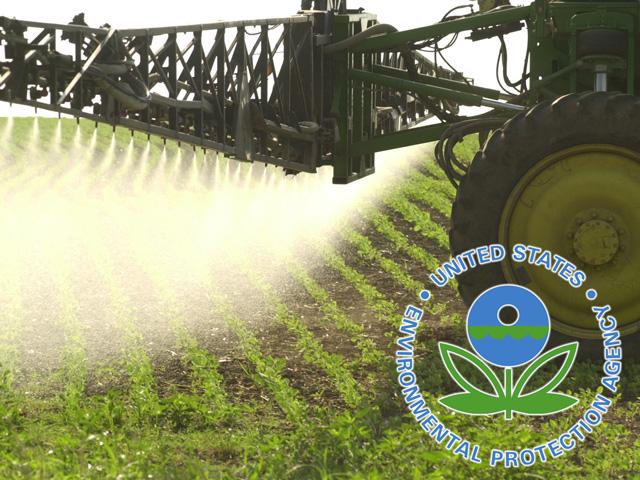Battle Over Pesticide Rules
Ag Groups Challenge Effort in Congress to Rewrite Federal Pesticide Regulations
OMAHA (DTN) -- More than 300 agricultural groups are now raising concerns about a pair of bills introduced in Congress that would tighten regulations over pesticides. If enacted, the bills would also require EPA to immediately ban the sale and use of some pesticides, such as chlorpyrifos, neonicotinoids and paraquat.
The Weed Society of America and its affiliates warned in a news release that the bills "would put science in the backseat and let politics drive such decisions."
The agricultural groups are pushing back on a pair of matching bills in the House (HR 7940) and Senate (S. 4406), the "Protect America's Children from Toxic Pesticides Act." The bill was introduced jointly in early August by a small number of Democrats -- 16 in the House and five in the Senate.
The bills have an uphill road toward enactment, given Congress' recent pesticide legislation and the fact that they would effectively overhaul the Federal Insecticide, Fungicide and Rodenticide Act (FIFRA).
One provision of the bills would immediately suspend EPA registrations if Canada or more than one country in the European Union bans a pesticide. The pesticide registration for that product would then undergo another review by EPA. The legislation notes the EU now bans at least 72 pesticides that are still allowed for use in the U.S., including chlorpyrifos, neonicotinoids and paraquat.
The bill would also ban the sale or use of existing pesticide stocks once a registration has been canceled or suspended. Earlier this year, after the Ninth Circuit Court of Appeals vacated the registration of three dicamba herbicides, EPA issued a cancellation order permitting commercial applicators to sell off any existing stocks of dicamba products in their possession and permitting farmers to use existing stocks of dicamba through the summer.
The bill would also permit any member of the public to submit a petition for a pesticide to be labeled as a "dangerous pesticide," which would require an agency review.
P[L1] D[0x0] M[300x250] OOP[F] ADUNIT[] T[]
In a letter to members of Congress, more than 300 agricultural groups stated the legislation "misrepresents the science-based safety standards that are used to protect farmers, workers and the public."
In their letter, the agricultural groups laid out regulatory requirements already in place at EPA looking at "economic, social, and environmental benefits and risks," with "special considerations for risks to infants and children" when determining the registration of a product. Pesticides also undergo reregistration at least once every 15 years. EPA also can choose to initiate further reviews if needed. The letter notes, "Instead, the legislation as introduced would gut decades of federal regulation and scientific progress, undermining the work of EPA's career scientists in the evaluation of pesticide safety and oversight of pesticide registration and use."
Both bills were referred to the House and Senate Agriculture Committees. Yet, Congress just last year passed the reauthorization of the Pesticide Registration Improvement Act (PRIA) to oversee pesticide registrations through 2023. The updated PRIA legislation details how EPA conducts reviews for its pesticide decisions. That timing makes it unlikely Congress would immediately rewrite the laws on pesticide review.
All the chemical registrations implicated by the proposed bills have seen their share of legal challenges and regulatory scrutiny in the past decade.
Chlorpyrifos, in particular, has been the source of many past lawsuits over its alleged health effects on people, especially children and infants. The organophosphate chemical was once common in many household insecticides, until EPA and industry negotiated an end to all domestic uses of it in 2000. Now it is primarily used in agricultural crops and is the main ingredient in what was Dow AgroScience's -- now Corteva Agriscience's -- Lorsban insecticide.
In the face of research and lawsuits in 2015, EPA proposed revoking all food residue tolerances for chlorpyrifos, which would essentially end the chemical's legal use on crops. But that decision was reversed in 2017 by Scott Pruitt, former administrator of the EPA.
In February 2020, Corteva announced its decision to voluntarily end production of Lorsban, but EPA is continuing its review to renew the chemical's registration, and generic versions of it are likely to remain on the market. See more from DTN here: https://www.dtnpf.com/… and here: https://www.dtnpf.com/….
The Fresno (California) Bee also reported this week that more than 90 lawsuits could be filed by farmworker families in central California against Corteva and pesticide applicators. https://www.fresnobee.com/…
Neonicotinoids have also been a controversial group of chemicals used in agriculture, where they are used primarily as foliar insecticides or within seed treatments in row crops such as corn and soybeans. Their use has been implicated in the decline of pollinator health in the past decade, and a number of other countries have banned or greatly restricted their use, including Canada.
Some U.S. states and municipalities have also introduced and enacted legislation to limit their use, but the EPA remains committed to renewing the federal registrations of the three most common neonicotinoid insecticides in use in agriculture -- clothianidin, imidacloprid and thiamethoxam. The agency released a proposed interim decision renewing their registrations in the spring, with some tweaks to label language and some use restrictions. See more here: https://www.dtnpf.com/….
Other chemicals implicated in the bill, including paraquat, also appear likely to remain on the market under current regulatory standards.
EPA released its assessments supporting its re-registration in October 2019, over the objections of some environmental groups. The chemical is banned in a number of other countries, but its use has increased in the U.S. significantly since 2013, largely in response to herbicide-resistant weed problems. It is used primarily in corn, soybeans, cotton, pastures and orchards. In December 2019, EPA released new labels and training requirements for the chemicals, which are underway now. See more here: https://www.dtnpf.com/….
Chris Clayton can be reached at Chris.Clayton@dtn.com
Follow him on Twitter @ChrisClaytonDTN
Emily Unglesbee can be reached at Emily.unglesbee@dtn.com
Follow her on Twitter @Emily_Unglesbee
(c) Copyright 2020 DTN, LLC. All rights reserved.





